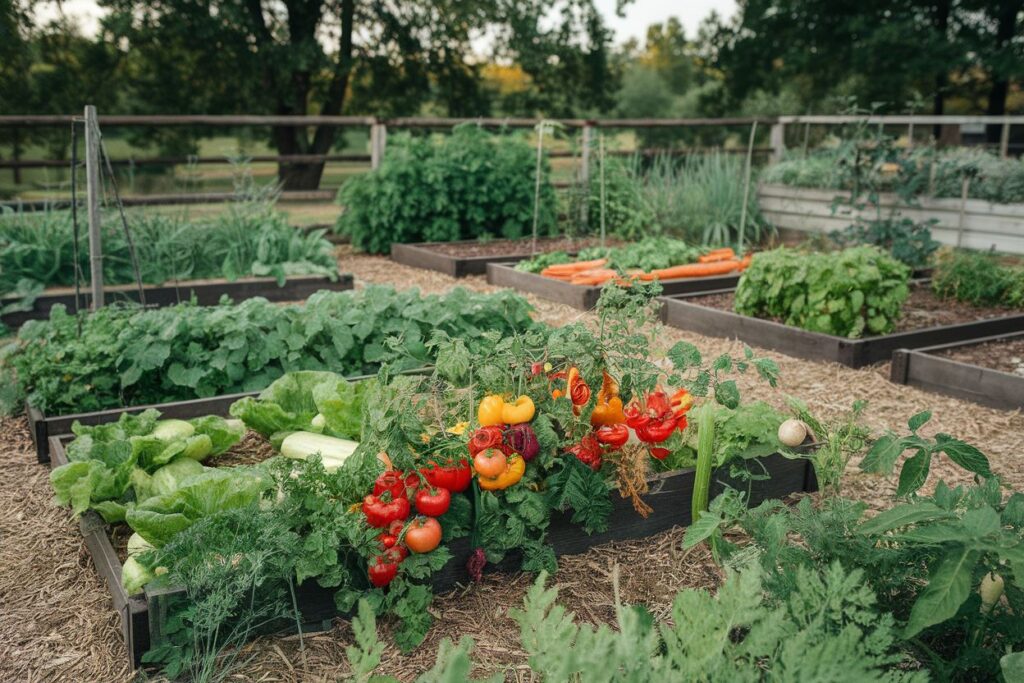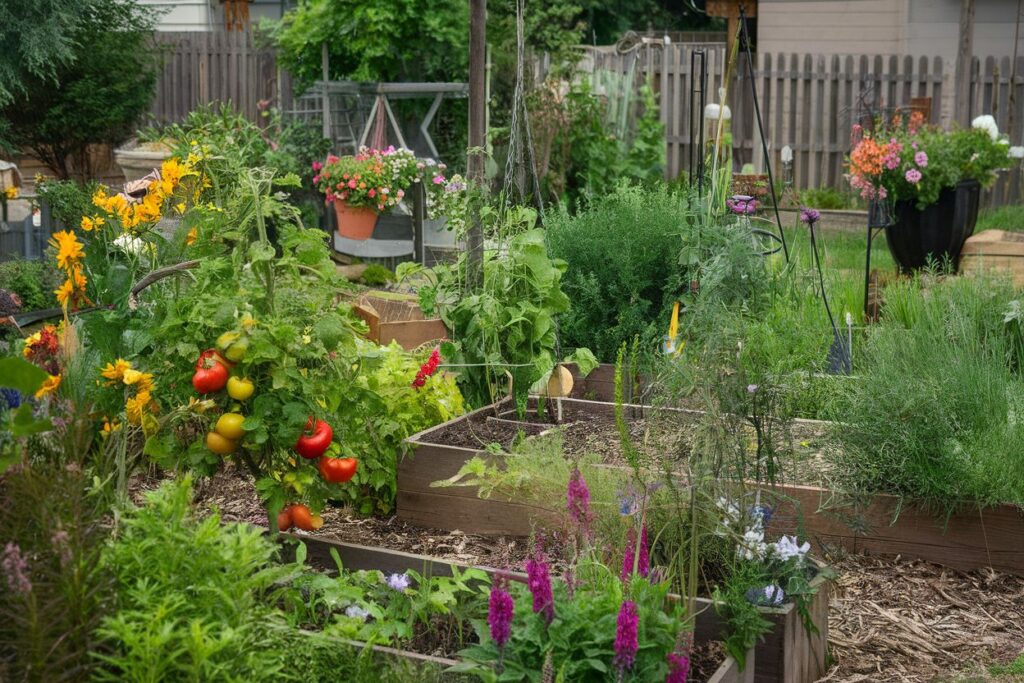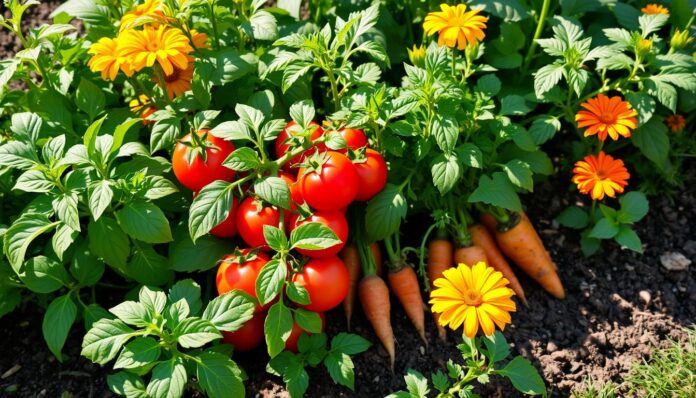Well, do you know What vegetables grow best together? Growing a successful vegetable garden is more than just planting seeds. Companion planting is a smart way to make your garden stand out. It involves choosing plants that help each other grow, creating a healthy garden ecosystem.
Gardeners in the United States use companion planting to boost their garden’s success. By knowing how vegetables interact, you can grow more food, fight pests, and keep plants healthy. Whether you’re new or experienced, learning about plant combinations can greatly improve your garden.
Companion planting is not just about placing plants side by side. It’s about building relationships that help the whole garden. These pairings can improve soil, fight pests, and grow stronger vegetables with less work.
I will dive into the world of vegetable companion planting. You’ll find out which plants are best together, how to plan your garden for growth, and secrets for a productive garden.
Understanding the Principles of Companion Planting
Companion planting turns simple vegetable growing into a complex garden ecosystem. It lets gardeners create spaces where plants help each other grow better. This way, different plants work together to make the garden more productive.
Plants talk to each other in amazing ways that many gardeners miss. Some plants send out chemicals that keep pests away from their neighbors. Others help improve the soil naturally.
Benefits of Strategic Plant Placement
Planting strategically is more than just arranging plants. It’s about making a balanced garden where pests are naturally kept away. Using crop rotation and companion planting can cut down on the need for harmful chemicals.
How Plants Interact in the Garden
Plants connect through underground networks. Some plants act as guards, keeping pests away or attracting helpful pollinators. This complex interaction makes the garden strong and productive.
Natural Pest Control Through Companion Planting
Choosing the right plants can help manage pests naturally. Some herbs and flowers keep pests away from vegetables. This method makes the garden healthier and more eco-friendly.
What Vegetables Grow Best Together: Essential Combinations

Creating successful vegetable pairings is an art in garden design. Complementary crops turn your garden into a thriving ecosystem. Plants support and enhance each other’s growth. Smart strategies help gardeners use space well and improve crop health.
Tomatoes and basil are a classic example of great pairings. Basil repels harmful insects and boosts tomato flavor and growth. Carrots and onions work well together too. Onions keep carrot flies away, creating a natural pest control.
Peppers and eggplants are perfect partners in the garden. They share growing needs and thrive together. This creates a supportive microclimate for both plants.
Plant compatibility is more than just where you plant them. You must think about their nutrient needs, root systems, and chemical interactions. Strategic planting increases yields, fights pests, and balances the garden ecosystem.
Some top vegetable combinations include:
- Beans and corn
- Spinach and strawberries
- Radishes and cucumber
By choosing the right pairings, gardeners create a dynamic and productive space. It mirrors natural ecological relationships.
The Three Sisters Method: Corn, Beans, and Squash
Native American agriculture brought us the Three Sisters method. It’s a smart way to grow food together, showing how to make the most of a small space. This method is all about working together to keep the garden healthy.
This method pairs corn, beans, and squash in a special way. Corn gives beans a place to climb. Beans help the soil by adding nitrogen. Squash keeps weeds down and keeps the soil moist.
Historical Significance of the Technique
“Agriculture is our wisest pursuit, because it will in the end contribute most to real wealth, good morals, and happiness.” – Thomas Jefferson”
Long before we knew about sustainable gardening, Native farmers used the Three Sisters method. It helped them grow food well, even in tough conditions. This method was smart for the environment and for growing food.
Planting Layout and Spacing Guidelines
To grow a Three Sisters garden, you need to plan. Start by planting corn seeds in small mounds, about 4 feet apart. When corn is 4-6 inches tall, plant bean seeds around it. Then, plant squash seeds between the mounds, giving them room to spread.
Maintaining the Three Sisters Garden
Keeping the garden healthy is important. Water well, pull weeds, and make sure each plant gets enough sun. Since these plants work together, taking care of one helps the whole garden.
Root Vegetables and Their Ideal Companions

Growing root crops is a fun challenge for gardeners. They aim to boost their underground vegetable production. Companion planting can make your garden more productive and healthy, creating a thriving ecosystem.
Carrots do well with certain plants that protect and improve their growth. Onions and leeks near carrots keep away carrot fly, a pest that harms root crops. Tomatoes are great neighbors, offering shade and improving soil structure through their roots.
Potatoes grow better with beans nearby, which fix nitrogen in the soil. This helps root vegetables have stronger roots. Horseradish and marigolds keep pests away, protecting your underground vegetables.
Beets pair well with lettuce and onions. These combinations save space and protect your plants from pests. Strategic planting boosts your root crops’ health and yield.
When planning your garden, think about how different plants interact. Proper spacing and pest control methods are key. They help create a productive and thriving garden ecosystem.
Tomato Companion Planting Strategies
Tomato gardening needs careful planning and smart plant placement. The right pairings can make your garden grow better and avoid problems.
Companion planting balances your garden. The right herbs can keep tomatoes healthy, keep pests away, and boost garden output.
Best Herbs to Plant with Tomatoes
Some herbs are great with tomatoes. Basil keeps pests away and makes tomatoes taste better. Parsley attracts good bugs that protect tomatoes. Oregano fights pests and grows well with tomatoes.
Vegetables That Enhance Tomato Growth
Choose vegetables that help tomatoes grow. Carrots and onions keep pests away and improve soil. Asparagus also benefits from being near tomatoes, making a better garden.
Plants to Avoid Near Tomatoes
Knowing which plants don’t get along with tomatoes is key. Don’t plant potatoes, cabbage, or fennel near tomatoes. They might steal nutrients, attract pests, or slow down tomato growth. Picking the right companions helps your plants thrive.
Leafy Greens and Their Growing Partners
To grow a successful salad greens garden, you need to pick the right plants to grow together. Not all plants get along, but some are great friends. By choosing the right herbs and plants that keep pests away, your garden will flourish.
Lettuce and spinach love to grow with chamomile and dill. These herbs attract good bugs and make the soil better. Kale does well near rosemary and thyme, which keep pests away.
“A diverse garden is a healthy garden” – Experienced Organic Gardener
Marigolds are amazing for keeping pests off your salad greens. They add color and protect your plants. Nasturtiums also keep pests away and add tasty flowers to your salads.
Think about how plants interact in your garden. Some improve the soil, while others attract bees or keep pests out. By choosing the right companions, your salad greens will grow strong and healthy.
Common Companion Planting Mistakes to Avoid

Gardening success comes from knowing how plants interact. Many gardeners face challenges in creating their perfect garden. They often make mistakes that harm their harvest.
Companion planting needs careful planning and attention to detail. Experienced gardeners know that spacing and rotation are key. These elements help create a thriving garden ecosystem.
Space Management Errors
One big mistake is not spacing plants right. Overcrowding can cause plants to fight for nutrients and spread diseases. It also limits air flow. Gardeners must research each plant’s space needs for the best growth.
Incompatible Plant Combinations
Not all plants get along. Some veggies compete for nutrients or release chemicals that harm others. Knowing which plants are good friends is crucial for a successful garden.
“A well-planned garden is like a symphony – each plant must be in the right place to create beautiful music.” – Garden Wisdom
Timing and Seasonal Considerations
Planting at the right time is important. Misjudging when to plant can lead to poor harvests. Gardeners need a planting calendar that fits their local climate and each plant’s needs.
Crop rotation keeps the soil healthy and prevents pests. By changing plant families each season, gardeners keep their soil rich and their garden productive.
Final Thoughts
Sustainable gardening is more than just picking plants. It’s about designing your garden to reach its full potential. Companion planting is a smart way to grow more by pairing plants together.
Learning to plant companions takes time and attention. Every garden is different, with plants interacting in special ways. Gardeners who succeed experiment and learn from their gardens over time.
Having a variety of crops is key to a strong garden. By planting different plants together, you can fight pests, improve soil, and grow healthier plants. This guide shows you how to create a garden that’s full of life and less reliant on chemicals.
Companion planting is for everyone, from new gardeners to seasoned pros. Start small, keep exploring, and let your garden show you its secrets.











